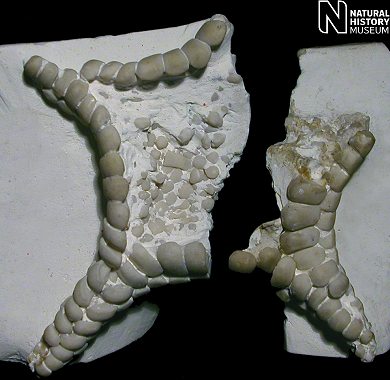 A A |
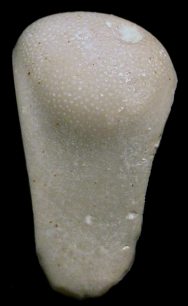 B B |
|
Pycinaster (Spencer, 1907) |
Large and robust starfish with slender, elongate arms. The genus is characterised by a tall and swollen marginal frame, particulary the superomarinal ossicles of the disc. Several species are recognised and these are distinguished by the form of the marginal ossicles; those of Pycinaster angustatus have a smooth outer surface and are moderately swollen; those of P. magnificus are very large, particularly swollen and gently pitted; those of P. crassus are ornamented with a small number of pronounced tubercles; those of P. senonensis are smooth but with at a sharp pit in the swollen area. Though isolated marginal ossicles are common in the White Chalk, well preserved individuals are exceptionally rare Chalk fossils and only likely to be encountered in the Seaford Chalk.
 A A |
 B B |
1). (A) Pycinaster angustatus; aboral view of a well preserved specimen (x1.5, Bowerbank Collection, BMNH (British Museum (Natural History) London) E2580). (B) Pycinaster magnificus; isolated superomarginal from the disc, displaying the pitted surface and swollen form characteristic of this species (x6, Friars Bay, Peacehaven, Newhaven Chalk Formation, Randell Collection, RR1454). Image (A) © 2005 The Natural History Museum, by kind permission.
 A A |
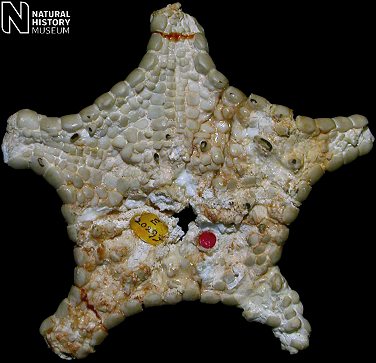 B B |
2). Pycinaster angustatus; Aboral (A) and oral (B) views of a uniquely well preserved, but sadly much decayed specimen, heavily coated for its own protection (x1.3, Micheldever, hampshire, Seaford Chalk, Blackmore Collection, BMNH (British Museum (Natural History) London) E20293. Images © 2005 The Natural History Museum, by kind permission.
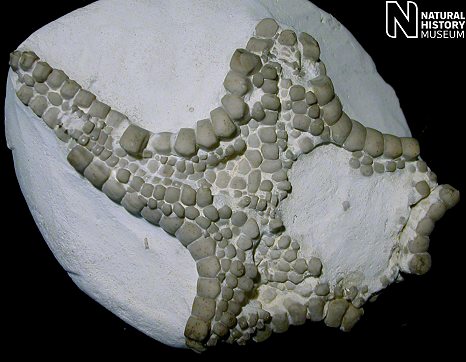 |
3). Pycinaster crassus; oral view of a well preserved specimen (A) x1.5, BMNH (British Museum (Natural History) London) E2576. Image © 2005 The Natural History Museum, by kind permission.
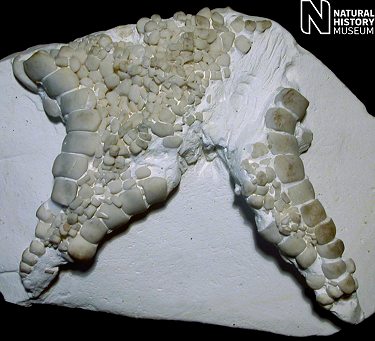 A A |
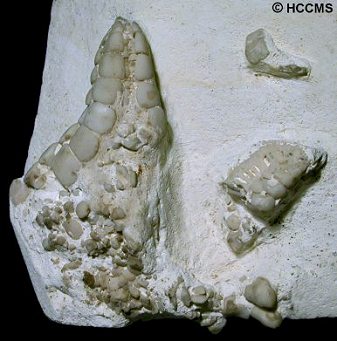 B
B |
4). Pycinaster angustatus; oral views of two suspiciously similar specimens which may possibly belong together; both are similary preserved and both are disrupted across the central disc by an apparent burrow; (A) x1.6, Sussex, BMNH (British Museum (Natural History) London) 35506; (B) x1.7, White Chalk, HCCMS (Hampshire County Council Museum's Service) collection, stored at Gosport Museum, G1983.364, by kind permission of Dave Kemp, HCCMS. Image (A) © 2005 The Natural History Museum, by kind permission.
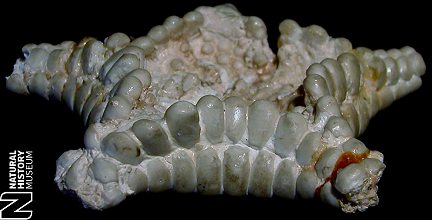 |
5). Pycinaster angustatus; lateral (side) view of an exceptionally preserved specimen, displaying the tall and robust marginal fram which characterises Pycinaster (x1.3, Micheldever, hampshire, Seaford Chalk, Blackmore Collection, BMNH (British Museum (Natural History) London) E20293. Image © 2005 The Natural History Museum, by kind permission.
 |
6). Pycinaster angustatus; lateral view of a well preserved specimen displaying how the large and tall marginals of the disc differ from the relatively small marginals of the arms (x2.5, Bowerbank Collection, BMNH (British Museum (Natural History) London) E2580). Image © 2005 The Natural History Museum, by kind permission.
 A A |
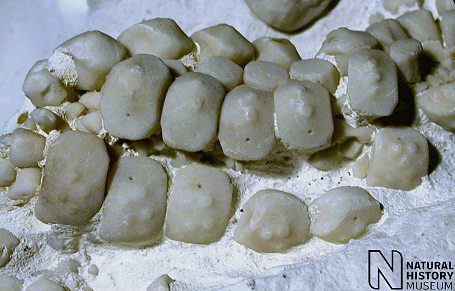 B B |
7). Pycinaster crassus; aboral (A) and lateral (B) views of a partially articulated arm from the type specimen, note the pronounced tubercles which define this species ((A) x1.8, (B) x3.5, Kent, Taylor Collection, BMNH (British Museum (Natural History) London) 35498. Images © 2005 The Natural History Museum, by kind permission.
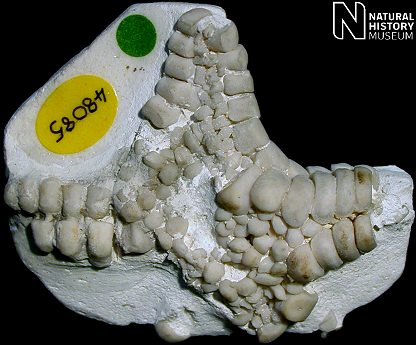 A A |
 B
B |
8). (A) Pycinaster angustatus; aboral view of a unique juvenile specimen (x2.7, Sussex, BMNH (British Museum (Natural History) London) 48085. (B) Pycinaster cf. angustatus; oral view of the arm tip (x3.5, Hampshire?, White Chalk, HCCMS (Hampshire County Council Museum's Service) collection, stored at Gosport Museum, G1983.364, by kind permission of Dave Kemp, HCCMS ). Image (A) © 2005 The Natural History Museum, by kind permission.
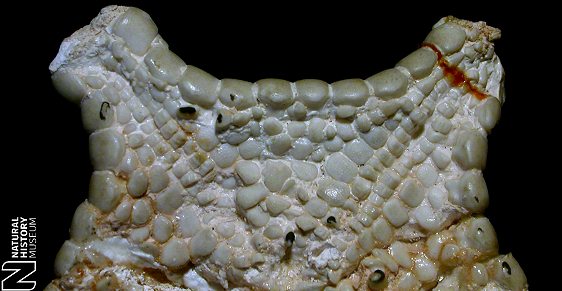 |
9). Pycinaster angustatus; a uniquely well preserved oral surface (x2.5, Micheldever, hampshire, Seaford Chalk, Blackmore Collection, BMNH (British Museum (Natural History) London) E20293. Image © 2005 The Natural History Museum, by kind permission.
------
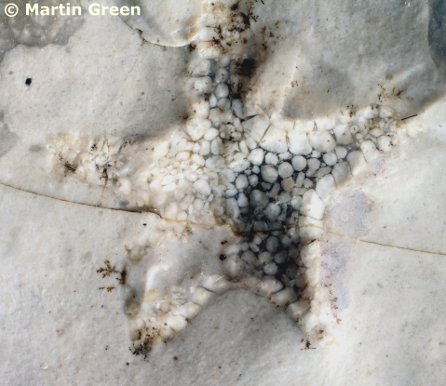 A A |
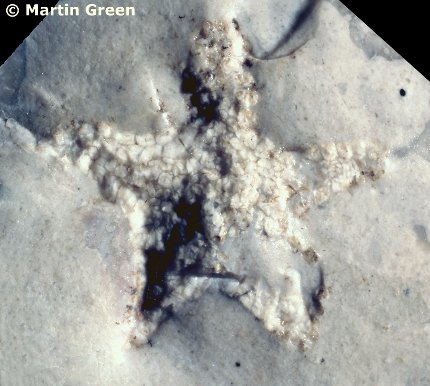 B B |
10). Pycinaster sp?; Part (A) and counterpart (B) images of a unique exquisetly articulated juvenile individual (x5.0, White Chalk, Dorset, Sixpenny Handley, Martin Green Collection). Images © 2011 Martin Green, by kind permission.
------
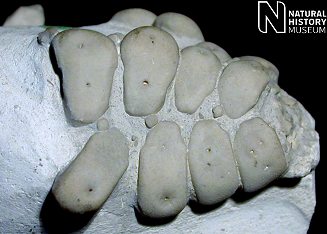 A A |
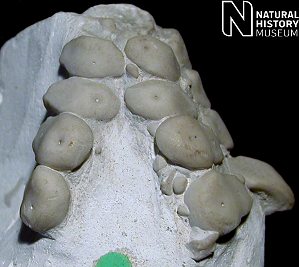 B B |
11). Pycinaster senonensis; lateral (A) and aboral (B) views of the fragmentary type specimen which preserves the junction between an arm and the disc ( x2.0, BMNH (British Museum (Natural History) London) E2561. Images © 2005 The Natural History Museum, by kind permission.
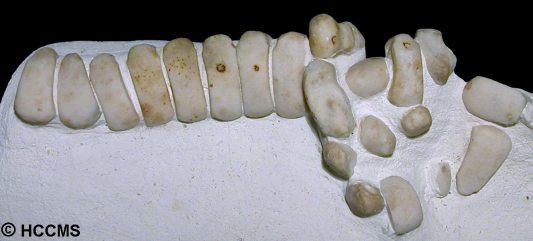
12). Pycinaster cf. magnificus, lateral (side) view of a partial marginal frame, displaying clearly how tall the marginals are (x1.6, Hampshire?, White Chalk, HCCMS (Hampshire County Council Museum's Service) collection, stored at Gosport Museum, G1983.366, by kind permission of Dave Kemp, HCCMS);
 |
13). Pycinaster sp.; lateral view of the inferomarginal frame of the disc (x2.8, Mantell Collection, BMNH (British Museum (Natural History) London) E2628. Image © 2005 The Natural History Museum, by kind permission.
|
|
14). Pycinaster cf. angustatus; lateral view of the upturned arm (x3.1, Hampshire?, White Chalk, HCCMS (Hampshire County Council Museum's Service) collection, stored at Gosport Museum, G1983.364, by kind permission of Dave Kemp, HCCMS ).
 A A |
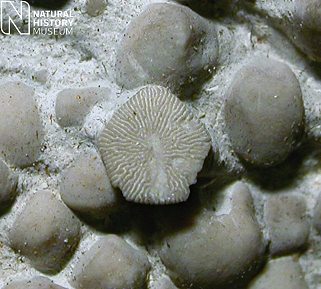 B B |
15). Pycinaster sp.; aboral views of a partial disc; (A) general view (x1.5); (B) detail of the madreporite (x6.6); antell Collection, BMNH (British Museum (Natural History) London) E2628. Images © 2005 The Natural History Museum, by kind permission.
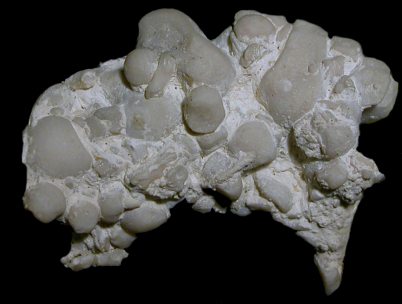 A A |
 B
B |
16). (A) Pycinaster magnificus; a pellet of disarticulated ossicles, discharged by an unidentified predator, bryozoans are also present (x3.5, Friars Bay, Peacehaven, Newhaven Chalk Formation, RR1194). (B) Pycinaster cf. angustatus, tip of the arm broken along the ambulacra, exposing the beautifully preserved adambulacral and ambulacral ossicles (x4.5, Hampshire?, White Chalk, HCCMS (Hampshire County Council Museum's Service) collection, stored at Gosport Museum, G1983.364, by kind permission of Dave Kemp, HCCMS ).